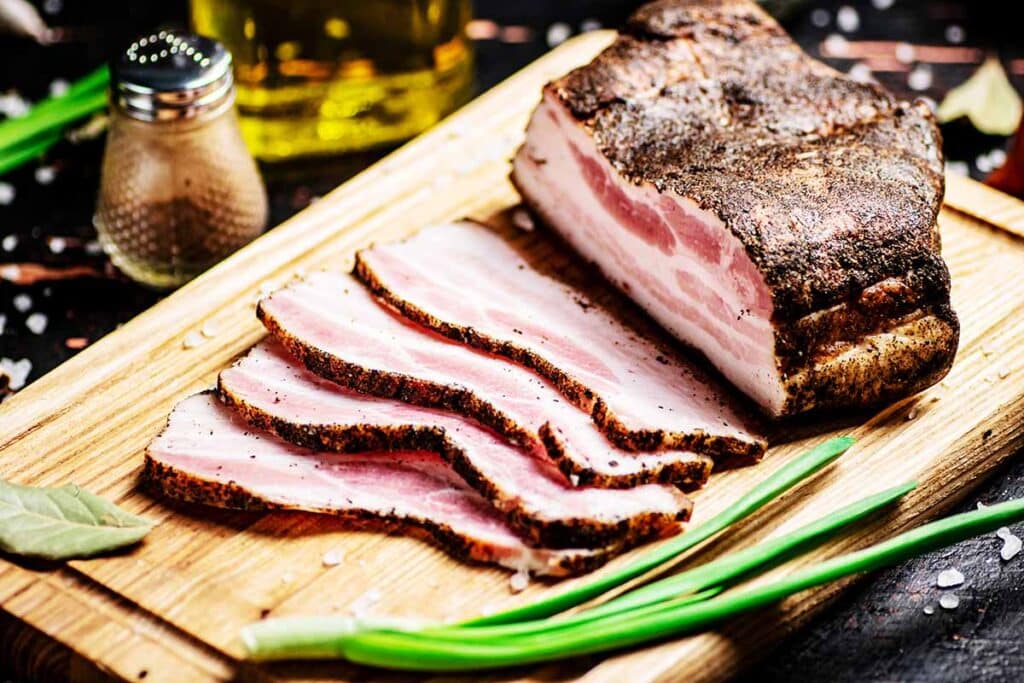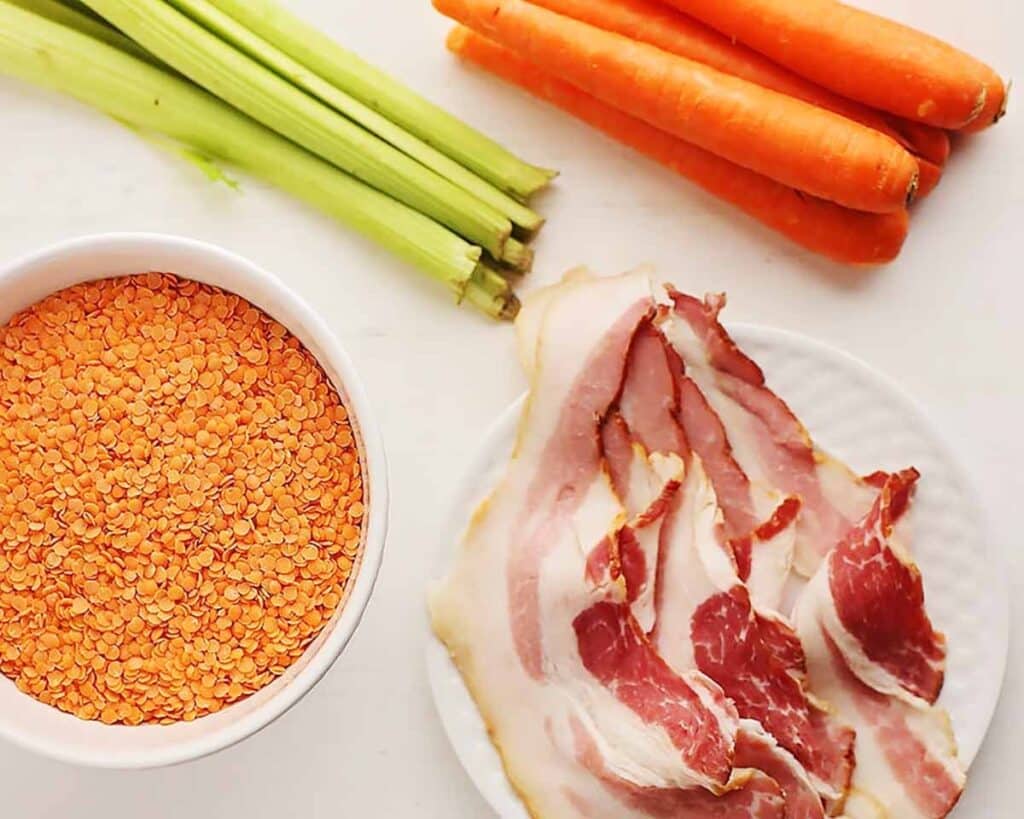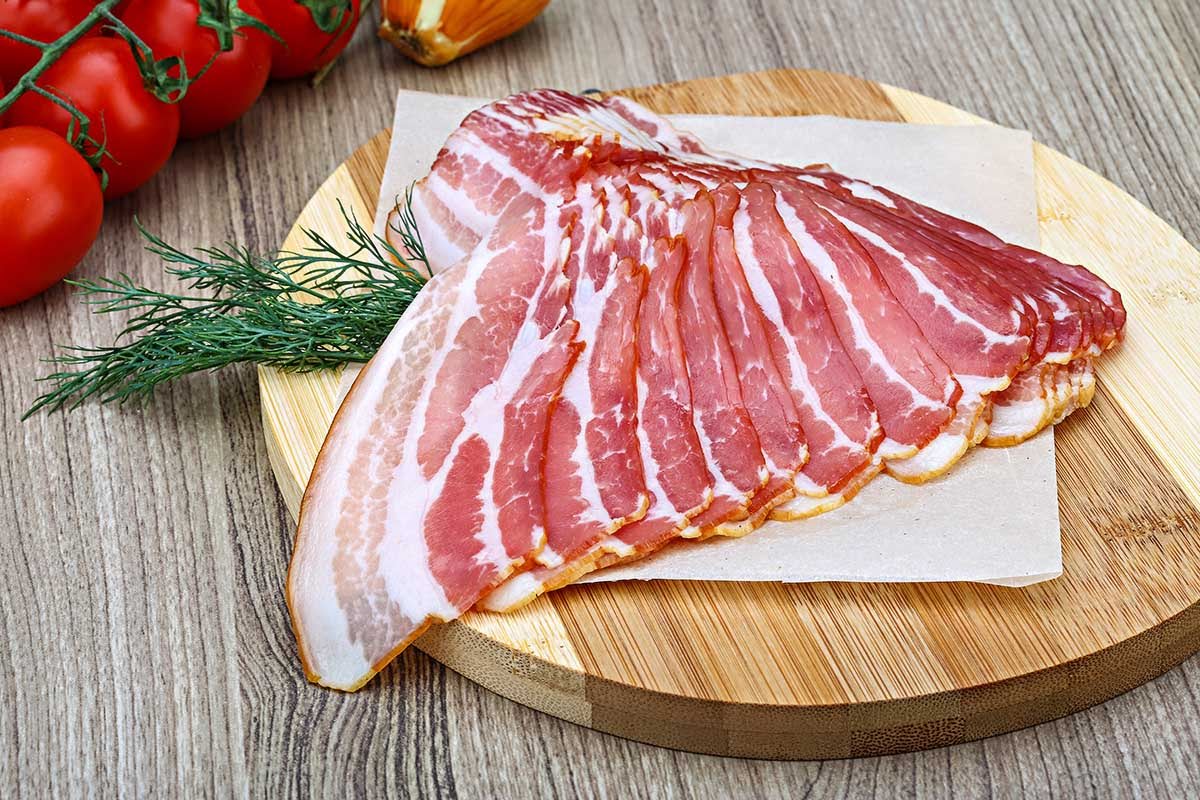Discover the perfect guanciale substitute! In this article, we explore delicious alternatives that will elevate your culinary creations.
Only a few ingredients can rival the rich and savory flavor of guanciale. This traditional cured meat gives the classic pasta carbonara its distinct taste. What if you’re missing guanciale? Dont worry, in this article we will explore many options from Pancetta to pork belly.

Guanciale is an exquisite Italian cured meat from the succulent pork cheek.
Its name comes from the Italian word “guancia,” which translates to “cheek.”
People cure the meat with salt, sugar, and spices to make guanciale. Unlike other cured meats, guanciale does not undergo a smoking process. For this reason, it does not have a smoky taste. Instead, guanciale boasts a delicate balance between sweet and salty flavors.
Due to its distinct delicious taste, guanciale is a sought-after ingredient. However, guanciale hails from Central Italy and can be difficult to find in other parts of the world.
If your recipe calls for it and you don’t have any, here are your top Guanciale substitutes.

Pancetta’s versatility make it a top guanciale substitute. They are both are Italian cured meats, after all.
Note that guanciale comes from the pig’s cheek, while Pancetta comes from the belly.
Despite this distinction, their preparation methods yield comparable flavors and textures.
One significant advantage of Pancetta is its wide availability. You can easily find it in most regions.
Pancetta may lack the strong pork flavor and delicate texture of guanciale. Still, it offers a delightful taste experience. Its milder flavor makes other ingredients shine while adding a savory, salty essence.
Notably, Pancetta’s fat renders beautifully during cooking. Like guanciale, it infuses dishes with richness. This rich flavor makes it a suitable swap in popular Italian pasta dishes.
Tips:
Like guanciale, Pancetta does not require cooking. You can use it in raw dishes, but it is also a good addition to cooked ones.

Prosciutto is another Italian cured meat you can use to replace guanciale in recipes. There are two types of prosciutto, namely prosciutto crudo and prosciutto cotto.
Crudo is cooked, while cotto is raw but cured. You can use both varieties as a guanciale substitute. However, you should opt for prosciutto cotto for the closest flavor match.
The main distinction between prosciutto and guanciale is in the cut. Prosciutto comes from the pork leg, making it a leaner and healthier option.
Its lower fat content means the dish will not have the velvety and rich texture you’ll get from guanciale.
Nevertheless, prosciutto will add flavor and texture to elevate your culinary creations.
Tips:
Prosciutto is typically available in thin slices. It is perfect for sandwiches and salads. If you need thicker cuts, request them from the butcher.

Bacon is another excellent substitute for guanciale, offering various appealing qualities. For the best results, opting for unsmoked bacon is advisable for Italian-inspired recipes.
Do note that any bacon will have a sweeter taste than guanciale.
It can change the overall profile of your dish. However, this flavor is an advantage if you enjoy sweet dishes.
Also, compared to guanciale, bacon has less fat and a milder pork flavor. It does excel when it comes to crispiness. If you need something that crisps up when cooked, bacon is your best bet.
Lastly, bacon is widely available. It is a household breakfast staple, so it makes a quick replacement.
Tips:
If you only have smoked bacon, you can still use it to replace guanciale. Blanch it first to reduce the smoky and salty flavors. Then, rinse and pat dry before cooking to prevent oil spatter.

Chorizo is a delicious and spicy cured sausage originally from Spain and Portugal. It has a distinct flavor and texture that adds a delightful kick to dishes.
This guanciale replacement has a slightly smoky flavor, garlic undertones, and subtle heat. Its solid and dense texture delivers a satisfying melt-in-your-mouth sensation.
Substituting guanciale with chorizo ensures a seamless transition. After all, you will not compromise taste or texture.
The spiciness of chorizo also enhances the overall flavor of dishes. Moreover, chorizo’s versatility allows you to use it in countless recipes.
Tips:
Chorizo pairs well with peppers and tomatoes. If your recipe has these ingredients, use chorizo for the best results.

Lardo is another Italian cured meat. It uses the pig’s back fat, and as such, it has a high fat content.
For this reason, lardo is a fantastic guanciale alternative. It melts beautifully when cooked, so it works perfectly for dishes where you need to render the fat.
Lardo offers creaminess and silky texture to dishes, too. You may use it in pasta, bread, and pastries.
It does not taste as meaty as guanciale, but it can still enrich your recipes with its fattiness.
Lardo adds just the right amount of richness to maintain flavorful dishes. The good thing is that it does this task without overpowering your recipes.
Tips:
Cut the lardo into small cubes and sauté until the fat renders. Its edges will turn golden brown and will elevate your recipes.

Salt pork is a viable alternative to guanciale. It offers unique qualities that can enhance various dishes. Despite its name, salt pork does not have an excessively salty taste.
It closely resembles slab bacon as it uses pork belly. However, it is fattier than both bacon and guanciale.
The good thing about this option is that it does not undergo a smoking process. For this reason, its flavor does not stray away from guanciale.
This type of meat is more affordable than most options on this list.
Tips:
Salt pork is saltier than guanciale. To use it as a swap, rinse the meat to remove some of its saltiness and ensure that your dish will still have a balanced taste. You may also opt to reduce the amount of the other salty ingredients in your dish.

Pork jowl is one of the best swaps for guanciale due to its similarities in the cut and curing process. Like guanciale, pork jowls come from the pig’s cheek, too. As a result, the fat content of pork jowl closely resembles that of guanciale.
You’ll get the same rich and creamy texture when you cook pork jowl. It is an excellent option for rendering fat in sauces such as al amatriciana.
The main difference is that pork jowl has a higher sodium content. On the bright side, this meat is an inexpensive cut of meat. Plus, you can find it in most supermarkets, making it an accessible option.
Tips:
To ensure that your dish does not become overly salty, reduce the amount of your other salty ingredients. If your recipe calls for adding salt, you may skip it altogether to compensate for the salty flavor of pork jowl.

Pork belly is a suitable substitute for guanciale due to several reasons. First, just like guanciale, pork belly is not smoked. This characteristic is an important consideration when seeking an alternative.
Second, it has comparable fattiness. For this reason, it delivers a similar richness to dishes.
Third, the versatility of this cut makes it a top choice for various recipes that call for guanciale.
After all, pork belly’s tender meat provides a similar mouthwatering experience.
Tips:
You can add it to classic pasta dishes like carbonara and amatriciana. Using them as toppings on pizzas also works. Remember that belly is not cured like guanciale. Add salt and go extra on the seasonings to achieve a closer flavor match.
The American equivalent of guanciale is salt pork. Salt pork is a cut of pork belly cured with salt but not smoked, just like guanciale. It shares a similar fatty texture. You can use it as a substitute in recipes that call for guanciale. There may be variations due to differences in curing and salting methods.
The skin of guanciale is typically not eaten. People usually remove it before using it in recipes. The skin is tough and chewy and doesn’t soften during cooking. Guanciale is popular for its rich fat content and flavor from the meat rather than the skin.
Guanciale and prosciutto are both cured meats from Italy, but they have notable distinctions. Guanciale uses pork cheeks and boasts a rich, fatty flavor. In contrast, prosciutto is a delicious cured meat that uses pork legs. This cured ham has a sweet and delicate profile.
Several viable swaps can elevate your recipes when you do not have guanciale. Your top choices are Pancetta, bacon, prosciutto, lardo, and bacon.
Pancetta, for one, is an excellent and easily accessible substitute for guanciale. Bacon is also a great swap offering its unique sweetness and crispiness. Prosciutto, both crudo and cotto, can provide a similar taste.
When picking the best swap, it’s crucial to consider the flavor, fat content, and availability. Doing so ensures a successful outcome.





